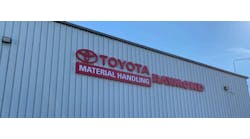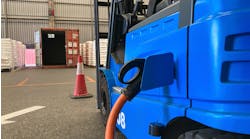Introducing Tech to Material Handling: Consider the Human Element
In the quest to increase productivity in material handling and manufacturing environments and be more responsive to the changing interests and expectations of the consumer, companies are increasingly embracing new technology. While this is by no means a new trend, the pace of adoption does seem to be quickening as Big Data, Internet of Things (IoT) solutions and advanced robotics become increasingly accepted within our society
Where we once (recently) relied solely upon paper checklists to fulfill orders, we now use handheld scanners, mobile computers and warehouse management systems (WMS) to facilitate those tasks. It seems like every day there is yet another connected and/or automated technology being proposed as a viable option to fulfill a wide variety of warehousing and distribution needs.
Of course, new technology often brings added complexity. Even the best-designed technologies will have learning curves and require process changes and/or new behaviors to mitigate complications, simplify implementation and deliver promised benefits.
Each new technology introduced into a facility challenges managers to ensure that employees can continue to perform their work in a safe, intuitive and positive fashion while contributing to the bottom line. Unfortunately, given the increased number of potential interaction points with technology and the relative lack of precedence for some of the advancements, this is often not as straightforward as one may think.
It is important to remember that any technology can be unsafe or negatively impact ergonomic efforts when used improperly or is not supported by the proper planning. In fact, in certain cases this could even lead to a softening of the productivity gains promised by the implementation.
To be truly successful, new technology implementations need to embrace an approach that is attentive to human factors and ergonomics. In all cases, the key focus should revolve around how operators and employees will interact with the technology as they use it to perform everyday tasks.
As you integrate new technologies into your environment, there are several factors you should consider to help ensure you maximize the value of your investment. These include:
Integrating the needs of the user into implementation planning
While your integration team proceeds through the stages of planning and implementation, at least one of the team members should be tasked with viewing everything through the experience of an operator. This will ensure that the team maintains an appreciation for the work context, physiological needs and cognitive requirements of your employees.
While you and your team might understand how the technology may help a single aspect of a task or offer a specific benefit, it is important to determine the impact it may have on other aspects of the employees’ work as well. How could the new technology be used or misused? Will its use hinder the completion of other tasks or interfere with other technologies? When should operators use the technology, and through what modality should interaction (e.g., voice, touch) and feedback (e.g., auditory, visual, haptic) occur? Are there known limitations that will apply to the warehouse or operators? These represent only a handful of the types of human-centered questions that you and your team should address before introducing new technology.
Conducting an audit
Similar to a safety audit, a human-centered technology implementation audit helps you identify possible concerns or issues regarding potential human interaction(s) with the new technology, whether they be ergonomic, safety or utilization related. It also helps you identify any adjustments that may be needed to help ensure a seamless and safe integration into your warehouse environment.
For instance, if automated vehicles are utilized in an environment with operator-driven trucks, those operators will now require special instructions on how to co-exist with and work alongside these vehicles. As illustrated in this example, the audit also provides information you can use to assess the next factor: training.
Adjusting the training, policies and processes
The questions you ask and the information you gather during the audit will help define any adjustments you may need to make to your training program, policies and/or processes.
For instance, if you introduce wearable technology and automation to your low-level order picking, you need to consider the best way for operators to interact with the technology to maintain or increase productivity levels without diminishing ergonomic best practices. Training needs to be developed for operators who will use the technology, as well as other employees who will encounter or work alongside it. Processes will need to be revised to ensure pathways for the vehicles are free of clutter and employees have clear sight of the vehicles in operation to avoid accidents.
Understanding the context for use and general work environment
Finally, when implementing new technology it is important that you understand how an operator or employee currently performs their function and how the new technology will change this interaction. What impact might interaction with the new technology have on employees’ ability to perform other tasks? Could it negatively impact the situational awareness of an employee by requiring too much mental attention from that employee? Depending on the application and the technology, the way the function is currently performed could be completely changed.
Thought should also be given to the environment in which the technology will be used. When and where will it be used? Is this something that will only be interacted with while the equipment is static and motionless, or will the interaction occur while moving through dynamic areas with lots of environmental activity? As you consider these questions, you may realize that additional training and possibly even process alterations may be needed to ensure that safety and productivity levels remain favorable.
To better understand changes to the work environment, a recommended practice is to have a member of the integration team spend time on the warehouse or manufacturing floor before the technology is introduced to document how employees currently perform their functions. Then later, after introduction, observe those employees again to confirm anticipated interactions and contrast how the technology has changed their work. This will allow you to quickly uncover possible issues and/or challenges to the successful adoption of the technology, before they have a chance to become problematic.
While the future of technology has never looked so promising, managers should never implement new technology just for the sake of having new technology. In order to truly maximize potential benefits, managers should view each piece as part of a larger whole and recognize that all circumstances are not equal. By ensuring that the human factor is included in planning technology implementation, managers will improve the operator experience, which ultimately helps boost productivity, safety and operator well-being throughout the entire operation.
Jess Gilland, Ph.D., CPE is senior human factors engineer with forklift manufacturer Crown Equipment Corp.



